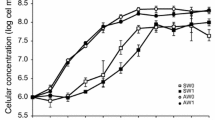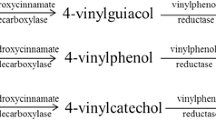Abstract
Three red grapevine varieties, Touriga Nacional, Syrah and Cabernet Sauvignon, were evaluated for their susceptibility to spoilage by two strains of Brettanomyces bruxellensis during grape juice fermentation and in finished wine. B. bruxellensis ISA 2211 survived well during both alcoholic and malolactic fermentations. The 4-ethylphenol concentration at the end of malolactic fermentation was 176 µg L−1 for T. Nacional, 190 µg L−1 for C. Sauvignon and 149 µg L−1 for Syrah. These levels were slightly increased during 3 months of incubation, even though no culturable cells of B. bruxellensis could be detected after malolactic fermentation. However, a viable but non-culturable (VBNC) population of 3–4 log cells mL−1 was observed in all grape varieties when analyzed by flow cytometry. On the other hand, commercial varietal wines, inoculated with of B. bruxellensis ISA 1791, could attain levels of 6–8 log CFU mL−1 and 4-ethylphenol reached 1750, 1512 and 2707 µg L−1 in T. Nacional, C. Sauvignon and Syrah, respectively. Overall, the production of 4-ethylphenol was mostly dependent on the existence of growing B. bruxellensis populations, regardless of the grape variety. In finished wines, 4-ethylphenol was always produced in concentrations far above its preference threshold, indicating that T. Nacional, Syrah and C. Sauvignon are equally susceptible to the “horse sweat” taint.





Similar content being viewed by others
References
Bisson LF (1999) Stuck and sluggish fermentations. Am J Enol Vitic 50(1):107–119
Jolly N, Augustyn O, Pretorius I (2003) The effect of non-Saccharomyces yeasts on fermentation and wine quality. S Afr J Enol Vitic 24(2):55–62
Malfeito-Ferreira M (2011) Yeasts and wine off-flavours: a technological perspective. Ann Microbiol 61(1):95–102. doi:10.1007/s13213-010-0098-0
Chatonnet P, Dubourdieu D, Boidron JN (1995) The influence of Brettanomyces/Dekkera sp. yeasts and lactic acid bacteria on the ethylphenol content of red wines. Am J Enol Vitic 46(4):463–468
Chatonnet P, Boidron JN, Dubourdieu D (1993) Influence des conditions d’élevage et de sulfitage des vins rouges en barriques sur leurs teneurs en acide acétique et en éthyl-phénols. Journal International des Sciences de la Vigne et du Vin 27:277–298
Renouf V, Falcou M, Miot-Sertier C, Perello MC, De Revel G, Lonvaud-Funel A (2006) Interactions between Brettanomyces bruxellensis and other yeast species during the initial stages of winemaking. J Appl Microbiol 100(6):1208–1219. doi:10.1111/j.1365-2672.2006.02959.x
Renouf V, Lonvaud-Funel A (2004) Racking are key stages for the microbial stabilization of wines. Journal International des Sciences de la Vigne et du VIn 38:219–224
Gerbaux V, Jeudy S, Monamy C (2000) Étude des phénols volatils dans les vins de Pinot noir en Bourgogne. Bulletin de l’OIV 73(835–36):581–599
Pérez-Prieto LJ, López-Roca JM, Martínez-Cutillas A, Pardo-Mínguez F, Gómez-Plaza E (2003) Extraction and formation dynamic of oak-related volatile compounds from different volume barrels to wine and their behavior during bottle storage. J Agric Food Chem 51(18):5444–5449
Dias L, Pereira-da-Silva S, Tavares M, Malfeito-Ferreira M, Loureiro V (2003) Factors affecting the production of 4-ethylphenol by the yeast Dekkera bruxellensis in enological conditions. Food Microbiol 20(4):377–384. doi:10.1016/S0740-0020(03)00023-6
Romano P, Marchese R, Laurita C, Saleano G, Turbanti L (1999) Biotechnological suitability of Saccharomycodes ludwigii for fermented beverages. World J Microbiol Biotechnol 15(4):451–454. doi:10.1023/A:1008948623024
Ciani M, Ferraro L (1997) Role of oxygen on acetic acid production by Brettanomyces/Dekkera in winemaking. J Sci Food Agric 75(4):489–495
Chatonnet P, Dubourdie D, J-n Boidron, Pons M (1992) The origin of ethylphenols in wines. J Sci Food Agric 60(2):165–178. doi:10.1002/jsfa.2740600205
Barata A, Caldeira J, Botelheiro R, Pagliara D, Malfeito-Ferreira M, Loureiro V (2008) Survival patterns of Dekkera bruxellensis in wines and inhibitory effect of sulphur dioxide. Int J Food Microbiol 121(2):201–207. doi:10.1016/j.ijfoodmicro.2007.11.020
Chandra M, Barata A, Ferreira-Dias S, Malfeito-Ferreira M, Loureiro V (2014) A Response Surface Methodology study on the role of factors affecting growth and volatile phenol production by Brettanomyces bruxellensis ISA 2211 in wine. Food Microbiol 42:40–46. doi:10.1016/j.fm.2014.03.002
Pollnitz AP, Pardon KH, Sefton MA (2000) Quantitative analysis of 4-ethylphenol and 4-ethylguaiacol in red wine. J Chromatogr A 874(1):101–109. doi:10.1016/S0021-9673(00)00086-8
Ávila LDd, Ayub MAZ (2013) Occurrence of Brettanomyces/Dekkera in Brazilian red wines and its correlation with ethylphenols. Braz J Microbiol 44(1):81–88
Ribéreau-Gayon P, Glories Y, Maujean A, Dubourdieu D (2006) The use of sulfur dioxide in must and wine treatment. Handbook of enology, vol 1, 2nd edn. Wiley, West Sussex, pp 193–216
Rodrigues N, Gonçalves G, Pereira-da-Silva S, Malfeito-Ferreira M, Loureiro V (2001) Development and use of a new medium to detect yeasts of the genera Dekkera/Brettanomyces. J Appl Microbiol 90(4):588–599
Savichtcheva O, Okayama N, Ito T, Okabe S (2005) Application of a direct fluorescence-based live/dead staining combined with fluorescence in situ hybridization for assessment of survival rate of Bacteroides spp. in drinking water. Biotechnol Bioeng 92(3):356–363. doi:10.1002/bit.20608
Branco P, Monteiro M, Moura P, Albergaria H (2012) Survival rate of wine-related yeasts during alcoholic fermentation assessed by direct live/dead staining combined with fluorescence in situ hybridization. Int J Food Microbiol 158(1):49–57. doi:10.1016/j.ijfoodmicro.2012.06.020
Andorra I, Monteiro M, Esteve-Zarzoso B, Albergaria H, Mas A (2011) Analysis and direct quantification of Saccharomyces cerevisiae and Hanseniaspora guilliermondii populations during alcoholic fermentation by fluorescence in situ hybridization, flow cytometry and quantitative PCR. Food Microbiol 28(8):1483–1491. doi:10.1016/j.fm.2011.08.009
Xufre A, Albergaria H, Inácio J, Spencer-Martins I, Gírio F (2006) Application of fluorescence in situ hybridisation (FISH) to the analysis of yeast population dynamics in winery and laboratory grape must fermentations. Int J Food Microbiol 108(3):376–384. doi:10.1016/j.ijfoodmicro.2006.01.025
Röder C, König H, Fröhlich J (2007) Species-specific identification of Dekkera/Brettanomyces yeasts by fluorescently labeled DNA probes targeting the 26S rRNA. FEMS Yeast Res 7(6):1013–1026. doi:10.1111/j.1567-1364.2007.00267.x
OIV (2006) Recueil International des Methodes d’Analyses des Vins et des Moutes, vol 2. Organisation Internationale de la Vigne et du Vin, Paris
Ribéreau-Gayon P (1972) Plant phenolics. Oliver and Boyd, Edinburgh
Bertrand A (1981) Formation des substances volatiles au cour de la fermentation alcoolique. Incidence sur la qualité du vin. In: Séances du Colloque Societé Française de Microbiologie. Reims, pp 251–267
Phowchinda O, Délia-Dupuy ML, Strehaiano P (1995) Effects of acetic acid on growth and fermentative activity of Saccharomyces cerevisiae. Biotechnol Lett 17(2):237–242. doi:10.1007/BF00127996
Cabrita MJ, Torres M, Palma V, Alves E, Patão R, Costa Freitas AM (2008) Impact of malolactic fermentation on low molecular weight phenolic compounds. Talanta 74(5):1281–1286. doi:10.1016/j.talanta.2007.08.045
Gerbaux V, Briffox C, Dumont A, Krieger S (2009) Influence of inoculation with malolactic bacteria on volatile phenols in wines. Am J Enol Vitic 60(2):233–235
Barata A, Laureano P, D’Antuono I, Martorell P, Stender H, Malfeito-Ferreira M, Querol A, Loureiro V (2013) Enumeration and identification of 4-ethylphenol producing yeasts recovered from the wood of wine ageing barriques after different sanitation treatments. J Food Res 2(1):p140
Martorell P, Barata A, Malfeito-Ferreira M, Fernández-Espinar MT, Loureiro V, Querol A (2006) Molecular typing of the yeast species Dekkera bruxellensis and Pichia guilliermondii recovered from wine related sources. Int J Food Microbiol 106(1):79–84
Cabinas JC, Cabinas MT, Cheynier V, Teissedre PL (2003) Tablas de composición. In: Flanzy C (ed) Enología: Fundamentos científicos y tecnológicos, 2nd edn. Mundi Prensa Libros SA, Madrid
Smith C (2013) Postmodern winemaking: rethinking the modern science of an ancient craft. Univ of California Press, Berkeley and Los Angeles, California
Acknowledgments
Authors wish to thank FCT (Fundação para a Ciência e a Tecnologia, Ministério da Ciência, Tecnologia e Ensino Superior) for financial support for the project PTDC/AGR-ALI/113565/2009 and for the postdoc (M. Chandra) Grant SFRH/BPD/70888/2010.
Author information
Authors and Affiliations
Corresponding author
Ethics declarations
Conflict of interest
The authors declare that they have no conflict of interest.
Compliance with Ethics Requirements
This article does not contain any studies with human or animal subjects.
Rights and permissions
About this article
Cite this article
Chandra, M., Madeira, I., Coutinho, AR. et al. Growth and volatile phenol production by Brettanomyces bruxellensis in different grapevine varieties during fermentation and in finished wine. Eur Food Res Technol 242, 487–494 (2016). https://doi.org/10.1007/s00217-015-2559-y
Received:
Revised:
Accepted:
Published:
Issue Date:
DOI: https://doi.org/10.1007/s00217-015-2559-y




